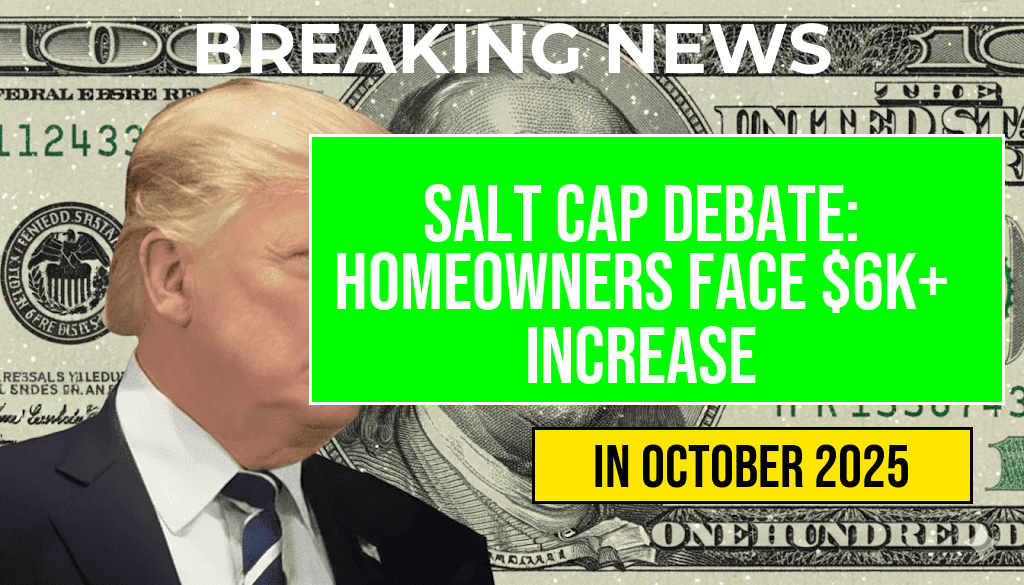Suburban homeowners across several states could face significant increases in property tax assessments if recent proposals to lift the existing salt cap are enacted. Currently, the cap limits property tax increases related to improvements or reassessments to $10,000 annually. Proposed changes could raise this threshold to as high as $40,000, potentially leading to increases exceeding $6,000 for many residents. These discussions are part of broader debates over local government funding, housing affordability, and tax equity. Homeowners and advocacy groups are expressing concern that such changes could disproportionately impact middle-class families, pushing some into higher tax brackets and affecting overall property affordability in suburban communities. Legislative committees are examining the proposals, weighing the need for increased revenue against the financial burden on residents with longstanding ties to their neighborhoods.
Understanding the Current Salt Cap and Proposed Changes
The Existing Salt Cap Framework
The salt cap was implemented to prevent rapid or excessive property tax increases following reassessments, especially after property improvements or market value changes. Under current law, homeowners can face reassessment increases, but the annual property tax hike is capped at $10,000 in assessed value. This provision aims to provide stability and predictability for residents while allowing local governments to adjust revenue collection gradually.
Details of the Proposed Increase
Proposals circulating in several state legislatures aim to raise the salt cap from $10,000 to potentially $40,000, a move that could result in substantial tax increases for suburban homeowners. According to policy analyses, such a change might translate into an annual increase of over $6,000 for households whose property values have appreciated significantly. Critics argue that this shift could erode the affordability benefits of existing law, particularly for middle-income families who have invested decades into their homes.
Potential Impact on Homeowners and Communities
Financial Implications
| Property Value Appreciation | Current Cap Impact | Proposed Cap Impact | Estimated Annual Increase |
|---|---|---|---|
| $200,000 | $10,000 | $40,000 | $6,000+ |
| $300,000 | $10,000 | $40,000 | $9,000+ |
| $400,000 | $10,000 | $40,000 | $12,000+ |
Community Response and Political Debate
Many suburban residents, particularly those on fixed incomes or with limited savings, express concern that these proposed increases could threaten their financial stability. Local advocacy groups warn that a higher salt cap might accelerate gentrification and displacement in some neighborhoods, as property taxes become less predictable and more burdensome. Conversely, some local officials argue that increasing the cap is necessary to fund essential services amid rising municipal expenses and declining state aid. The debate underscores the tension between maintaining fiscal sustainability and preserving affordability in growing suburban areas.
Legislative Outlook and Broader Context
Legislature’s Position
Legislative committees are currently reviewing the proposals, with hearings scheduled in several states. Supporters contend that raising the salt cap would enable municipalities to better fund infrastructure, schools, and emergency services without resorting to local sales or income taxes. Opponents caution that the measure favors higher-valued properties and wealthier homeowners, potentially widening economic disparities.
Broader Trends and Implications
The discussion reflects a broader national trend of balancing local revenue needs with housing affordability. As property values continue to rise in many suburban regions, policymakers grapple with ensuring that tax policies do not push residents out of their communities. The debate also highlights the importance of transparent assessment practices and fair tax distribution, with some calling for reforms that better target relief to long-term residents versus new or high-value property owners.
Additional Resources and Perspectives
- Wikipedia: Property taxes in the United States
- Forbes: Are Property Taxes Too High? What The Data Says
- National Association of Realtors: Tax Policy and Housing Affordability
Frequently Asked Questions
What is the proposed change to the salt cap for suburban homeowners?
The proposed change would increase the salt cap from $10,000 to $40,000, potentially impacting the costs for suburban homeowners.
How much could suburban homeowners see their costs increase due to the salt cap change?
Suburban homeowners could see an increase of over $6,000 in their costs, primarily due to the rise in the salt cap.
Why is the salt cap being increased from $10,000 to $40,000?
The increase aims to address rising costs and inflation, allowing homeowners and businesses to better manage expenses related to salt usage and other covered costs under the cap.
Who will be affected by the proposed salt cap increase?
Primarily, suburban homeowners and certain small businesses who rely on salt for road maintenance and other purposes will be affected by the change.
What are the potential benefits and drawbacks of increasing the salt cap?
The benefits include greater financial flexibility for homeowners and businesses to handle salt-related expenses, while the drawbacks may involve higher costs for residents and potential budget concerns for local governments.






